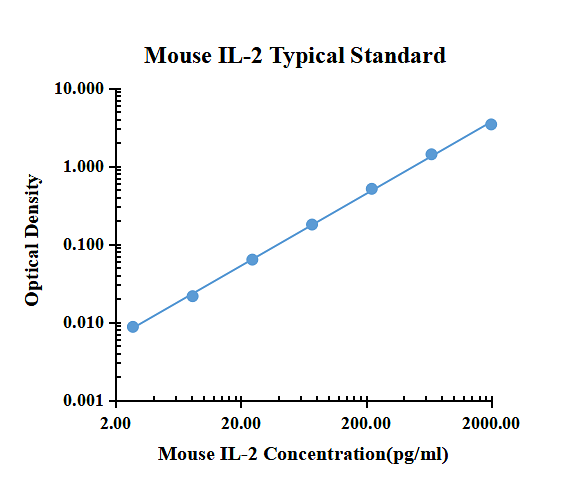Mouse IL-2 enzyme-linked immunoassay kit
| Specification | 96 Test |
|---|---|
| Sensitivity | 0.16 pg/ml (10 μl) |
| Standard Curve Range | 2.74~2000 pg/ml |
| Standard Curve Gradient | 7 Points/3 Folds |
| Number of Incubations | 2 |
| Detectable sample | Liquid phase sample of soluble substances. For example: serum, plasma, cell culture supernatant, tissue grinding liquid, etc. |
| Sample Volume | 10 μl |
| Type | Fully Ready-to-Use |
| Operation Duration | 120min |

| pg/ml | O.D. | Average | Corrected | |
|---|---|---|---|---|
| 0 | 0.01 | 0.009 | 0.0095 | |
| 2.74 | 0.0182 | 0.0182 | 0.0182 | 0.0087 |
| 8.23 | 0.031 | 0.031 | 0.031 | 0.0215 |
| 24.69 | 0.072 | 0.0736 | 0.0728 | 0.0633 |
| 74.07 | 0.1837 | 0.1918 | 0.1878 | 0.1783 |
| 222.22 | 0.5283 | 0.5149 | 0.5216 | 0.5121 |
| 666.67 | 1.4151 | 1.4413 | 1.4282 | 1.4187 |
| 2000 | 3.4657 | 3.409 | 3.4374 | 3.4279 |
Precision
| Intra-assay Precision | Inter-assay Precision | |||||
| Sample Number | S1 | S2 | S3 | S1 | S2 | S3 |
| 22 | 22 | 22 | 6 | 6 | 6 | |
| Average(pg/ml) | 43.5 | 121.4 | 362.0 | 18.9 | 152.5 | 341.9 |
| Standard Deviation | 2.2 | 6.0 | 19.4 | 0.4 | 2.8 | 12.5 |
| Coefficient of Variation(%) | 5.1 | 5.0 | 5.4 | 2.1 | 1.8 | 3.6 |
Intra-assay Precision (Precision within an assay) Three samples of known concentration were tested twenty times on one plate to assess intra-assay precision.
Inter-assay Precision (Precision between assays) Three samples of known concentration were tested six times on one plate to assess intra-assay precision.
Spike Recovery
The spike recovery was evaluated by spiking 3 levels of mouse IL-2 into health mouse serum sample. The un-spiked serum was used as blank in this experiment.
The recovery ranged from 81% to 108% with an overall mean recovery of 94%.
Sample Values
| Sample Matrix | Sample Evaluated | Range (pg/ml) | Detectable (%) | Mean of Detectable (pg/ml) |
|---|---|---|---|---|
| Serum | 30 | n.d.-0.67 | 21 | 0.23 |
Serum/Plasma – Thirty samples from apparently healthy mice were evaluated for the presence of IL-2 in this assay. No medical histories were available for the donors.
n.d. = non-detectable. Samples measured below the sensitivity are considered to be non-detectable.
Product Data Sheet
Background: IL-2
Interleukin 2 (IL-2), also known as T cell growth factor (TCGF), is a 15-18 kDa variably glycosylated alpha -helical polypeptide that is a member of the Common gamma Chain ( gamma c) cytokine family. It exists as a monomer and has a notably short half-life (< 30 minutes). Human IL-2 is synthesized as a 153 amino acid (aa) precursor that contains a 20 aa signal sequence plus a 133 aa mature region. The mature region is alpha -helical in nature, and contains one utilized O-linked glycosylation site at Thr3 plus three cysteines, two of which form an intrachain disulfide bond that is essential for activity. Mature human IL-2 shares 73%, 66%, 78% and 97% aa identity with canine, rat, feline and rhesus monkey IL-2, respectively. Although human IL-2 shares only approximately 60% aa identity with the highly polymorphic mouse IL-2, human IL-2 is known to be active on mouse IL-2 responsive cells. Cells reported to secrete IL-2 include gamma δ T cells, activated conventional CD4+ and CD8+ T cells, neurons, microglia, and hematopoietic stem cells.
The receptor for IL-2 (IL-2 R) is composed of three subunits, the 55 kDa CD25/IL-2 R alpha chain, the 70 kDa IL-2 R beta chain, and the 65 kDa Common gamma Chain. IL-2 first binds to CD25, the binary complex then recruits IL-2 R beta and gamma c to form the quaternary signaling complex. In addition to IL-2, IL-2 R beta is used by IL-15 in its quaternary signaling complex. gamma c also serves as a signaling receptor for IL-4, -7, -9, -15, and -21.
In vitro studies have shown an important role for IL-2 in T cell activation and expansion. In vivo, IL-2 is critical for the development, maintenance and function of regulatory T cells (Treg) which provide protection against autoimmune disease. On the other hand, IL-2 can also promote autoimmune inflammation in target organs through its roles in regulating the expression of T cell trafficking genes, and production of Th2 cytokines. Within the CD8+ T cell subset, IL-2 is essential for optimal primary responses and differentiation into terminal effector cells. IL-2 also promotes the development of activated CD8+ T cells into memory cells.

